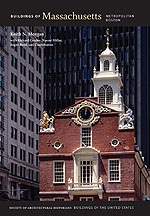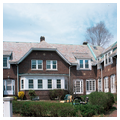A unique example in Boston of model housing in the Garden City tradition, Woodbourne retains the appearance of an English village for the working class. In 1910–1911 the Minot family sold their estates to the Boston Dwelling House Company (BDHC), established by directors of the Boston Elevated Railroad Company to provide affordable housing for its motormen and conductors. Frederick Law Olmsted Jr. developed the original landscape plans, but he resigned after disagreement with Henry Howard, BDHC president; Robert Anderson Pope of New York replaced him. Kilham and Hopkins designed a wide range of housing forms for Woodbourne. Large apartment buildings on Hyde Park Avenue (now demolished) screened the more intimate community behind. The architects arranged two groups of brick complexes around a courtyard with multifamily, two-family, and single-family dwellings and added an island of small single-family cottages. Allen and Collens designed a similar series of houses along Southbourne Street. Nevertheless, Woodbourne never fulfilled the developers' goal. Beyond the reach of the average motorman, the well-appointed houses were purchased by the middle class.
You are here
Woodbourne
1911, Robert Anderson Pope and Kilham and Hopkins, and Allen and Collens. 90, 94, 96, 98 Florian St. 15, 21, 25, 30, 32–34, 36–46, 53–54, 56–58, 60–70, 72–74, 76, 78, 80–82 Southbourne St. 289–291, 296, 306 Wachusett.
If SAH Archipedia has been useful to you, please consider supporting it.
SAH Archipedia tells the story of the United States through its buildings, landscapes, and cities. This freely available resource empowers the public with authoritative knowledge that deepens their understanding and appreciation of the built environment. But the Society of Architectural Historians, which created SAH Archipedia with University of Virginia Press, needs your support to maintain the high-caliber research, writing, photography, cartography, editing, design, and programming that make SAH Archipedia a trusted online resource available to all who value the history of place, heritage tourism, and learning.





